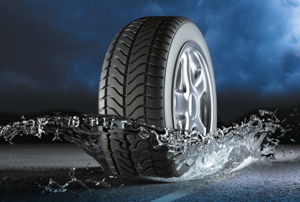Wet Weather Driving Advice
Wet conditions are frequently underestimated, but they can lead to potential hazards on the road. Road surfaces can become slippery and your view of the road may become distorted during rain showers, so it is important that you are prepared to deal with driving in wet weather.
Preparing for Wet Conditions

In the UK, rain showers and flooding can strike during any season, so you should ensure that your vehicle is ready to cope. You can do this by undertaking the following tasks every three weeks and before you set off on any long journeys.
Tyres
It is important that your tyres have adequate levels of tread in wet conditions, as this is what provides you with grip and reduces your risk of aquaplaning. You should frequently check that your tyres are above the legal minimum of 1.6mm; however, at The Tyre Group we would recommend replacing tyres when tread reaches 3mm. This is because at this point your gripping and handling capabilities are drastically decreased. Learn how to check your tyre tread here.
Windscreen Wipers
Heavy rain can distort your view of the road, so it is essential that your windscreen wipers are in good condition and can rapidly clear your windscreen. You should check them for damage and signs of wear and replace them if you do notice any tears or cuts. If your windscreen wipers leave smears on the glass when crossing the windscreen, this is another sign that they need to replaced.
Screen Wash
Rain can contain particles of dirt or mud and this can obstruct your view if you do not clean it off. Check that you have the correct level of screen wash so that you are able to quickly clear away any debris.
Slow Down
As rain falls, it mixes with oil on the surface of the road and makes it slippery, which can cause skidding. This is deceptively dangerous when it first starts to rain as there may not appear to be any hazardous conditions to watch out for.
To retain control of your vehicle, you should drive slowly when it starts to rain. This will enable your tyres to make better contact with the road, allowing for better traction and reducing your risk of skidding.
Keep your Distance
It takes longer to come to a safe stop on wet surfaces, so you must keep a larger distance than you usually would from the car in front. In addition, maintaining a larger space will give you adequate time to react if the vehicle ahead of you loses control of their own vehicle or comes to a sudden stop.
Be Considerate
During heavy rain you should be aware and considerate of other road users. If you are struggling to see the road ahead due to clouds, fog or rainfall you should use your dipped headlights or fog lights as appropriate. You should also take care not to splash pedestrians and cyclists when driving through water and remember that splashing a pedestrian with water on purpose as you drive past can be seen as a criminal offence.
Avoid Flooded Areas
Breakdowns that occur in wet weather are usually due to vehicles driving through flooded areas and causing damage to components such as the braking system or engine. For this reason you should make every effort to avoid driving through flooded areas and checking traffic updates for flood warnings if you are driving through an area prone to floods.
If you have no option other than to drive through a flooded part of the road, you should proceed slowly and carefully in first gear, ensuring that you have a clear route through. Wait for other vehicles to get past before you start as stopping and waiting in standing water can cause irreversible engine damage.
Never drive through water that is deeper than 6 inches standing or 4 inches moving and if you cannot judge the depth of the water, avoid the area at all costs.
How to React During Aquaplaning
Aquaplaning happens when you lose traction with the surface of the road due to a thin layer of water between the road and your tyres. It can cause you to lose control of your vehicle and this can be incredibly daunting when driving.
If you find yourself aquaplaning, slowly ease your foot off the accelerator and avoid braking, as this could cause you to skid and veer out of your lane. Avoid making any movements and allow your tyres to regain traction with the road. Once you feel contact made, gently steer the vehicle in the direction you want to travel and lightly pump your brake if you need to slow down.
For further advice and guidance for coping in wet conditions, contact your local Tyre Group branch.

























